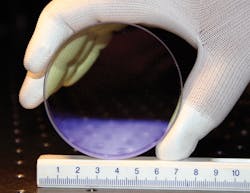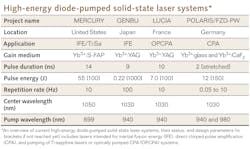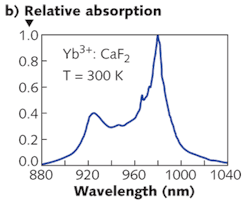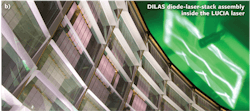SOLID-STATE LASERS: Very-large-scale DPSS lasers are coming
Recent developments in high-power diode-laser technology enable the setup of a new class of high-energy, diode-pumped lasers at an acceptable cost. Diode packaging, pump-light transport, and beam homogenization together with driver electronics will play a major role in fulfilling the reliability requirements.
To fully exploit the potential of large diode-pumped solid-state (DPSS) lasers, new laser materials are needed that allow a better match between the tailored emission wavelengths of diode-laser pump systems and the absorption wavelengths of the doped laser hosts. Additionally, the laser materials must simultaneously have a long fluorescence lifetime and high emission and absorption cross-sections. The preparation of large apertures with high-quality polish and coatings will require appropriate production facilities.
New Yb-doped laser materials
The pulse energy and average power of a large solid-state laser are limited mainly by the laser's efficiency and thermal-management capability; hence, diode pumping is preferred to flashlamp pumping. Many concepts for high-peak-power solid-state lasers are based on ytterbium (Yb3+)-doped host materials, which offer longer upper-state lifetimes (1 to 2 ms), a smaller quantum defect, and a similar emission wavelength when compared to neodymium (Nd3+)-based materials. In addition, Yb3+ is pumped in the 915 to 980 nm wavelength range, allowing the use of laser diodes with wall-plug efficiencies up to 70%.
Up to now, Yb:YAG has been the most important and best developed material. Recently, ytterbium-doped alkaline-earth fluorides such as calcium, strontium, and barium fluorides (Yb3+:CaF2, Yb3+:SrF2, and Yb3+:BaF2) have attracted interest for use in diode-pumped femtosecond lasers and amplifiers. These crystalline materials have recently been shown to compete with oxide crystals and glasses in terms of thermal conductivity. Because large single crystals and ceramics can be fabricated, the materials are suitable for high-energy and high-power laser operation. Also, Yb3+:CaF2 is suited to pumping at both 940 and 980 nm without the need for advanced wavelength stabilization of the pumping diodes (see Fig. 1).The spectroscopic properties of Yb3+-doped gain media result in high saturation fluencies for absorption and emission. The quasi-three-level system of Yb3+ requires a minimum pump intensity in the range of 5 kW/cm2 in order to bleach out the re-absorption at the laser wavelength at room temperature. This drives the demands for high-brightness laser diodes, advanced beam combination with low brightness loss for pumping, reasonable cost, and high reliability.
High-power diode-laser bars for pumping
Some existing programs have shown that the diode-laser module cost contributes significantly to system costs. This contribution depends on the level of integration and may exceed 50%.
Cost consideration starts with a close look at the cost per watt. A promising way to reduce it is to increase the power per diode-laser element. Such an element consists usually of a semiconductor edge-emitting chip 10 mm wide with several dozen parallel emitters arranged side by side, residing in a single optically active layer. All emitters are driven in parallel, producing a given power at a high operating current and voltage drop typically <2 V.
With the recent developments in diode-laser mounting technology, in conjunction with improvements in front-facet-coating technology, much higher optical peak powers as well as longer lifetimes are achievable for high-power diode-laser bars. By matching the coefficients of thermal expansion for the chip and heat sink, a sandwiched hard-solder mounting of diode-laser bars is possible, which together with backside conduction cooling via a ceramic-copper substrate results in peak powers of 300 W per bar and higher (see Fig. 2). A 500 W peak power per bar appears to be achievable before long.Conduction cooling of the devices is preferred over the use of direct water-cooled heat sinks, as water cooling would require the use of many O-ring seals–a potential leakage risk. Also, in terms of maintenance, conduction-cooled laser-diode modules are easier to replace.
To satisfy brightness requirements, micro-optical lensing is mandatory. Pre-aligned fast-axis-collimation (FAC) lens arrays would allow further labor cost reduction. Government funding and joint industry efforts support the development of even higher peak powers per bar (potentially with peak power up to 1000 W), which is still limited in practice due to the high drive currents. Improvements in chip efficiency, as well as improvements in front-facet durability, will help achieve these goals.
Diode designs with more than one active layer vertically stacked (nano stacks) allow reduction of the drive current, easing limitations on the electrical contacts. But pulsewidths are thermally limited to ~200 μs, which is too short for the envisioned laser materials. Collimation cannot be provided at the same quality as for the single-active-layer design, which reduces diode brightness and limits the application for laser pumping.
Pump engines
High-power diode-laser bars can be stacked in modules (such as an eight-bar stack) and can be arranged close to each other in a planar geometry. In terms of brightness, a minimum pitch of 1.5 to 2.0 mm between each bar is required due to space constraints of the FAC lenses and the thermal-spread needs. The drive current is provided from the backside and the mechanics act as electrical and mechanical contacts at the same time. Today, 2.4 and 3.2 kW modules at 1% duty cycle (1 ms pulsewidth, 10 Hz repetition rate) with wavelengths at 940 nm or 980 nm are available.
To concentrate the radiation emitted by a multistack pumping module (for example, a panel of laser-diode stacks with a net intensity of 2 kW/cm2 for pumping Yb3+-based lasers), focusing optics and beam homogenization are required. The brightness of a diode-stack panel can be increased by optical-beam combination. Spatial and polarization multiplexing can be applied to raise the brightness by a factor of at least 2 to 4. Additional costs have to be compared to the benefits.
Integrated diode-laser modules have been developed that provide >18 kW peak power at a duty cycle up to 3% in a quadratic ultraflat-top, low-ripple beam suited for laser pumping. Smaller modules as well as custom beam sizes and pulsewidths ranging from microseconds to milliseconds can be produced. Combinations of several diode modules with driver electronics, cooling, monitoring, and interlock system are called pump engines; these allow easy integration into user setups. In future large-scale systems, module size should be optimized for compactness and handling.
Upcoming large-scale DPSS lasers
Two challenging large-scale European laser projects–High Power Laser Energy Research (HiPER; www.hiper-laser.org) and the Extreme Light Infrastructure (ELI; www.extreme-light-infrastructure.eu)–are in their preparatory phase. Regardless of the architecture, diode-pumped kilojoule-class lasers with a repetition rate in the 10 Hz to 1 kHz range are either used as primary sources for intense lasers or direct-laser-driven hot and dense plasma or accelerated particle generators.
The crystal Yb3+:CaF2 has been identified as a promising active laser material that allows efficient diode pumping. Quasi-continuous-wave diode bars providing peak powers in excess of 300 W can be used as a pump source. However, to turn these laser-diode chips into reliable, durable optical pump sources, careful design of heat sinks, packaging, and secured operation is necessary. The needed high brightness requires densely packed diode lasers with beam shapers and combiners, driver electronics, interlocks, and monitoring as well as pump-light homogenizers.
About the Author
Joerg Neukum
Director of Product Marketing, High Power Diode Lasers at Coherent
Joerg Neukum is Director of Product Marketing, High Power Diode Lasers at Coherent (Mainz, Germany).
Thomas Toepfer
Managing Director, Lastronics
Thomas Toepfer is Managing Director at Lastronics (Jena, Germany).
Joachim Hein
Senior Scientist, Institute of Optics and Quantum Electronics
Joachim Hein is a senior scientist at the Institute of Optics and Quantum Electronics (Jena, Germany).
Mathias Siebold
Scientist, Forschungszentrum Dresden-Rossendorf
Mathias Siebold is a scientist at Forschungszentrum Dresden-Rossendorf (Dresden, Germany).



